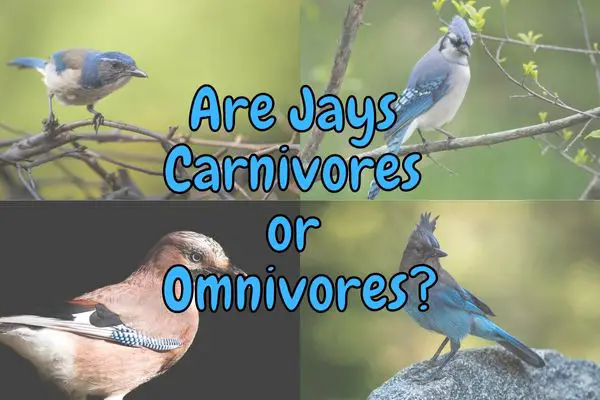Jays, like the Blue Jay or Steller’s Jay, are colorful birds that are known for their mischievous antics. These birds are found in wooded lands and backyards throughout North America and are very adaptable to different habitats.
Jays are omnivores and eat a wide variety of food items. In the wild, they eat acorns, nuts, berries, insects, small reptiles, and amphibians. They will also eat eggs and nestlings of other birds. During the winter months, jays will store acorns in tree crevices or bury them in the ground to eat later when food is scarce.
Personally, I love these birds due to their intellect and beautiful colors!
Jays are interesting birds to watch since they are very active and have a variety of calls and sounds that they use to communicate with each other. They sometimes even imitate the calls of other birds!
What are Jays and what do they eat?
Two of the most well-known Jays are the Blue Jay and the Stellar’s Jay which are the two only species of the genus “Cyanocitta”.
Some of the other more common Jay birds in North America are:
- Brown Jay
- Canada Jay
- Green Jay
- Mexican Jay
- Pinyon Jay
- California Scrub-Jay
- Florida Scrub-Jay
- Island Scrub-Jay
- Woodhouse’s Scrub-Jay
But here I will focus on the Blue Jay and Stellar’s Jay as these are best known to most people!
Blue jays are large, noisy, intelligent and curious birds that may live in large flocks and communicate with each other with loud, harsh squawks.
Blue jays are widespread and common throughout North America where they visit most American backyards and are common at bird feeders throughout most states.
The diet of a Blue Jay and Stellar’s jay is similar to that of other Jays and is primarily made up of fruits, nuts and seeds, but they also eat insects, small mammals, eggs, nestlings, reptiles, amphibians and sometimes eve other adult birds!
Their diet varies with the seasons but in the summer they mainly eat fruits, nuts and berries. In the winter they eat nuts, seeds, grains, berries and fruits, small mammals, eggs and nestlings.
Blue jays usually swallow food whole. They do not have a crop (a pouch in the throat), so their food stays in their stomachs until they digest it fully.
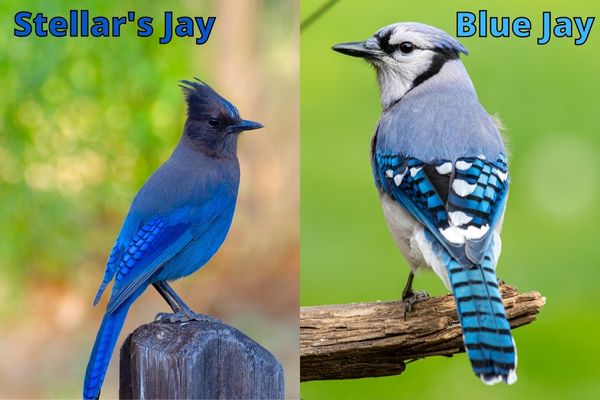
Blue jays are known for their intelligence. They are able to remember people they have met and the locations of food sources.
Stellar’s jays (Cyanocitta stelleri) are found in the western United States and southwestern Canada.
Blue jays and Stellar’s jays live together to some extend in social groups where they forage together and share food.
Are Blue Jays Carnivores?
Jays are generally omnivores. They eat both plants (such as seeds and grains) and animals, but mainly insects.
Jays are considered omnivores because their diet contains both plants and animals. However, they are not true omnivores because their diet consists mainly of animal food.
Being an omnivore means that you can act as both a carnivore and a herbivore depending on what you eat.
What about Blue Jays?
As a biologist with experience in avian research, I can confidently tell you that blue jays are not strictly carnivores.
They are considered omnivorous birds, which means their diet includes a combination of both plant and animal matter. This adaptability in their feeding habits has enabled blue jays to thrive in various habitats across North America, from forests to suburban areas.
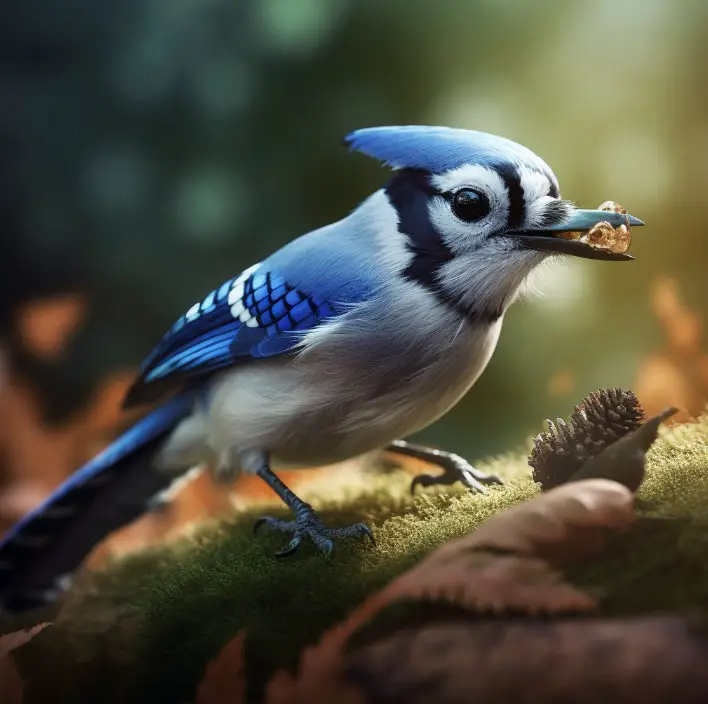
Blue jays have a diverse diet that primarily consists of nuts, seeds, and insects. I remember vividly observing blue jays during my fieldwork, as they foraged in the undergrowth of forests, searching for acorns, beech nuts, and other tree seeds. They are known to have a particular affinity for acorns, as well as sunflower seeds and peanuts, which they may opportunistically gather from bird feeders in residential areas.
However, blue jays are not limited to a vegetarian diet. During my time studying their feeding behaviors, I observed blue jays engaging in insect hunting expeditions. They would actively pursue and capture various insects, such as grasshoppers, beetles, caterpillars, and even spiders.
I recall watching a blue jay deftly pluck a caterpillar from a leaf, its vibrant blue feathers contrasting against the green foliage. These occasional carnivorous tendencies help supplement their nutritional needs, particularly during the breeding season when they require higher protein intake to nourish their young.
In addition to insects, blue jays have been known to consume small vertebrates on rare occasions. I recall a fascinating incident during my research when I witnessed a blue jay capturing and devouring a small lizard. While this behavior is not common, it demonstrates the opportunistic nature of blue jays, adapting their diet to include occasional meat sources when available.
It’s important to note that while blue jays incorporate animal matter into their diet, they do not rely exclusively on meat for sustenance. The majority of their diet consists of plant-based foods, including fruits, berries, and grains. I remember following blue jays as they hopped from branch to branch, plucking ripe berries from shrubs and trees. This feeding behavior not only aids in dispersing plant seeds but also provides blue jays with important nutrients and energy.
In conclusion, blue jays are versatile omnivores that exhibit a wide-ranging diet. Based on my experiences as a biologist studying these birds, blue jays are not classified as strict carnivores but rather as opportunistic feeders with a preference for plant-based foods.
While they do consume insects and occasionally small vertebrates, such behavior is supplementary to their primary reliance on nuts, seeds, fruits, and berries. This adaptability in their feeding habits allows blue jays to thrive in various environments and make use of available food resources.
When Are Blue Jay’s Carnivores?
Blue Jays mostly eat nuts and seeds, but they will feed as carnivores when they eat insects, caterpillars, eggs and sometimes small birds.
Throughout my years of research and personal experiences studying Blue Jays, I have observed these beautiful birds foraging in various habitats. I vividly remember watching Blue Jays hopping from branch to branch, meticulously selecting acorns from oak trees.
They are well-known for their ability to cache food, which involves storing and hiding nuts for later consumption. This behavior not only plays a crucial role in seed dispersal and forest regeneration but also demonstrates their strong reliance on plant-based resources.
While Blue Jays primarily feed on plant matter, it is important to note that they do include insects and other small invertebrates in their diet, especially during the breeding season when protein-rich food is necessary for raising their young.
I recall observing Blue Jays swooping down from tree canopies to capture insects mid-air, showcasing their agility and adaptability in acquiring a diverse array of food sources. This opportunistic feeding behavior allows them to take advantage of available resources and optimize their nutritional intake.
However, it is essential to distinguish between an occasional inclusion of animal matter in the diet and classifying a species as a carnivore. Blue Jays’ consumption of insects and other small invertebrates represents a relatively small fraction of their overall diet.
They lack the specialized adaptations, such as sharp teeth, claws, or a digestive system designed for efficiently processing and digesting animal flesh, which are commonly found in true carnivores like lions or eagles.
In my encounters with Blue Jays, I have also noticed their interactions with other birds and animals. They often exhibit territorial behavior, actively defending their feeding territories and nesting sites from potential competitors.
I recall witnessing aggressive encounters between Blue Jays and other bird species, particularly when resources were limited or during the breeding season. These interactions further reinforce their reliance on plant-based foods, as their territorial defense is primarily aimed at securing access to valuable plant resources rather than animal prey.
In conclusion, while Blue Jays demonstrate a diverse diet that includes insects and other small invertebrates, they are not considered carnivores. Their primary reliance on plant materials, such as nuts, seeds, and fruits, along with the occasional consumption of insects, classifies them as opportunistic omnivores.
Understanding the feeding ecology and dietary preferences of species like Blue Jays is vital for comprehending their ecological role in ecosystems and how they contribute to seed dispersal, forest regeneration, and the overall biodiversity of their habitats.
Are All Birds Omnivores?
No, not all birds are omnivores, but most birds are opportunistic feeders that will eat both plants and animals.
Are Jays Producers, Consumers or Decomposers?
As a biologist with experience in the field, I can confidently say that jays are neither producers nor decomposers.
Instead, jays are primarily classified as consumers in ecological terms. Let me delve into the details to provide a comprehensive explanation.
Firstly, it is essential to understand the concepts of producers, consumers, and decomposers in an ecosystem. Producers, also known as autotrophs, are organisms capable of synthesizing organic compounds from inorganic substances through processes like photosynthesis or chemosynthesis.
These organisms serve as the foundation of the food chain by converting sunlight energy or chemical energy into usable forms. Examples of producers include plants, algae, and some bacteria.
On the other hand, consumers, also known as heterotrophs, are organisms that rely on consuming other organisms or organic matter as a source of energy.
They cannot synthesize their own food and instead obtain nutrients by feeding on other living organisms. Consumers are further classified into primary consumers (herbivores), secondary consumers (carnivores), and tertiary consumers (top carnivores) based on their feeding habits and position in the food chain.
Lastly, decomposers are organisms that play a vital role in breaking down dead organic matter and recycling nutrients back into the ecosystem. They primarily feed on decaying plant and animal material, facilitating the decomposition process. Decomposers include bacteria, fungi, and certain invertebrates like earthworms.
Now, let’s focus on jays. Jays, such as the blue jay or the Eurasian jay, are medium-sized birds belonging to the family Corvidae. They are known for their vibrant plumage and intelligent behaviors. Jays, like other birds, are consumers in the ecological context. They are specifically classified as omnivorous consumers, as they have a diverse diet that includes both plant and animal matter.
In my personal experiences studying jays, I have observed that their diet consists of a variety of food items. Jays feed on a range of fruits, nuts, and seeds, making them consumers of plant material.
They are known to play a crucial role in seed dispersal as they cache and scatter seeds while foraging. Jays also consume insects, spiders, small invertebrates, and occasionally small vertebrates like nestlings or eggs, which makes them consumers of animal matter as well.
It’s worth noting that while jays do not fit the category of decomposers, they indirectly contribute to the decomposition process. When jays consume fruits or seeds, they may inadvertently drop or bury them in the soil, providing potential food sources for decomposers like bacteria or fungi.
These decomposers break down the organic matter, releasing nutrients that can be reabsorbed by plants, thus completing the nutrient cycle.
To summarize, jays are consumers in the ecological context due to their feeding habits, which include consuming both plant and animal matter. While they are not producers or decomposers, jays play an important role in seed dispersal and indirectly contribute to the decomposition process by providing organic matter for decomposers to act upon.
What Type of Consumer is a Jay?
Jays are omnivores, which means that their diet contains both plants and animals. However, jays are not considered true omnivores because their diet consists mainly of animal food.
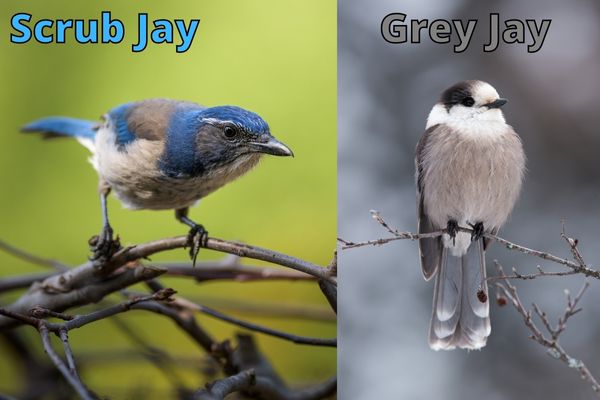
Can Jays be Considered Decomposers?
No. Because jays eat both plants and animals, they are omnivores, not omnivores. They are considered omnivores because their diet contains both plants and animals, but they are not true omnivores because their diet consists mainly of animal food.
Are Jays Autotrophs or Heterotrophs?
Jays are heterotrophs because they eat other living organisms. Practically no animals are autotrophic because animals do not get their energy directly from the sun like plants do. That is, animals like the jays cannot make their own energy!
Where are Jays in the Food Chain?
When considering their position in the food chain, it is important to understand their ecological niche and the interactions they have with other organisms. As a biologist with experience in studying avian ecology, I can provide you with an elaborate explanation of where jays fit into the food chain.
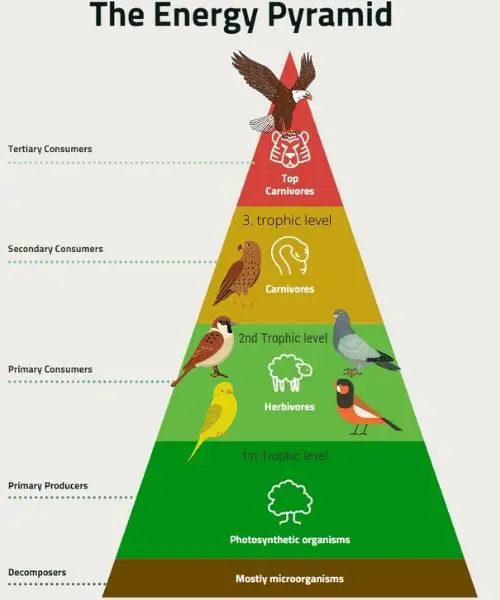
Jays are omnivorous birds, which means they have a diverse diet that includes both plant and animal matter. Drawing from my personal experiences of observing jays in the field, I have witnessed these birds feeding on a wide range of food items, such as insects, small mammals, bird eggs, nuts, seeds, fruits, and even human-provided food scraps. This flexibility in their diet allows jays to occupy various positions within the food chain, depending on the availability of resources in their environment.
At the primary level of the food chain, jays can consume plant matter, such as seeds, fruits, and nuts. I remember one particular instance during my research where I observed jays feeding on acorns. By consuming these plant resources, jays can serve as seed dispersers, aiding in the propagation of plant species. As they feed on fruits and disperse seeds through their droppings, jays contribute to the regeneration and maintenance of plant communities in their ecosystems.
Moving up the food chain, jays also consume insects, small vertebrates, and bird eggs. During my fieldwork, I once witnessed a jay deftly catching and consuming a grasshopper. In this way, jays can exert predation pressure on various invertebrate species, helping to regulate their populations. By controlling insect populations, jays indirectly influence the abundance and diversity of other organisms within their ecosystem.
Moreover, jays can have significant impacts on other bird species within the food chain. They have been observed raiding the nests of other birds, stealing eggs and even preying on nestlings. In one memorable occasion, I witnessed a jay raiding a songbird nest, a behavior that can have detrimental effects on the population dynamics of those particular species. Jays’ opportunistic behavior and dietary flexibility allow them to exploit available resources, but their predation on other bird species can also have cascading effects within the food chain.
Lastly, it is worth noting that jays are not immune to predation themselves. They have predators that include raptors, snakes, and mammals such as cats and foxes. I recall an instance where I found the feathers of a jay in an owl’s pellet during a study on owl feeding habits. This demonstrates that jays serve as a food source for higher-level predators, occupying a position lower in the food chain.
In conclusion, jays can occupy various positions within the food chain, depending on the availability of resources and the specific interactions within their ecosystems. They have a flexible diet that ranges from plant matter to insects, small vertebrates, and bird eggs.
As seed dispersers, insect predators, and nest raiders, jays have complex ecological roles that impact both the plant and animal communities around them. However, they also face predation from higher-level predators, reinforcing their place in the broader food web. Understanding the position of jays within the food chain provides insights into the dynamics and interactions of organisms within their ecosystems.
Jays are important for the ecosystem because they are omnivores. As they eat both plants and animals, they help to keep the balance in nature.
If there were no jays, then one type of food would dominate and the other would eventually die out.
What are Jay’s Natural Predators?
This depends a lot on the exact bird species, but the larger jays generally have fewer predators than the smaller ones.
Larger Jays like the Eurasian Jay or the even larger Brown Jay, for example, are some of the largest jays found in North America and they do not have as many enemies as the smaller jay species such as the Dwarf Jay or Siberian Jay.
But most Jay’s natural predators are hawks, owls, snakes, raccoons, and foxes – especially if they forage in cities such as the Blue Jay and Stellar’s Jay do!
As you can read more about in my article about the bird feeder hierarchy, blue jays are fairly high up in the bird feeder hierarchy and will be able to scare away smaller birds such as Cardinals and Robins.
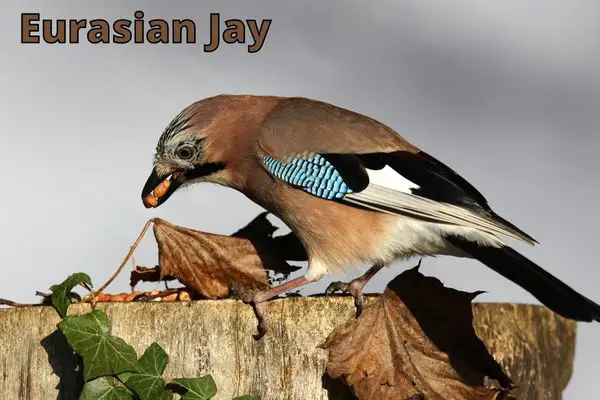
However, they do have respect for the larger bird species of their own family such as crows and ravens but also other large birds like the pileated woodpecker.
Conclusion
In this blog post, I have looked into the habitat of Jaybirds, their diet, and feeding habits!
Jays are very sociable birds that often flock together. They spend most of their time in the forest or woodland, particularly the larger or more mature trees.
Hay is the most important part of a jay’s diet, along with seeds and fruits. They also sometimes feed on the insects they catch on the roof of their mouths.
It is evident that jays show great flexibility in their diet, and can adapt to many different environments, whether they have forests, meadows, farmlands or gardens!

